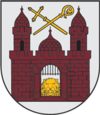Limbaži
| Limbaži | |||
|---|---|---|---|
| Town | |||

Limbaži old town
|
|||
|
|||
| Location in Latvia | |||
| Coordinates: 57°31′N 24°43′E / 57.517°N 24.717°ECoordinates: 57°31′N 24°43′E / 57.517°N 24.717°E | |||
| Country |
|
||
| District | Limbaži municipality | ||
| City status | 1385 | ||
| Government | |||
| • Mayor | Juris Žūriņš | ||
| Area | |||
| • Total | 9.021 km2 (3.483 sq mi) | ||
| Population (2008) | |||
| • Total | 8,705 | ||
| • Density | 989/km2 (2,560/sq mi) | ||
| Time zone | EET (UTC+2) | ||
| • Summer (DST) | EEST (UTC+3) | ||
| Postal code | LV-4001 | ||
| Calling code | 640 | ||
| Website | http://www.limbazi.lv | ||
Limbaži (![]() pronunciation , Estonian: Lemsalu, German: Lemsal, Livonian: Limbaž) is a town in the Vidzeme region of northern Latvia. Limbaži is located 90 km northeast of the capital Riga. The population is 8705 people. During the Middle Ages, as part of Livonia, Limbazi was a fortified town with stone walls, second in importance only to Riga.
pronunciation , Estonian: Lemsalu, German: Lemsal, Livonian: Limbaž) is a town in the Vidzeme region of northern Latvia. Limbaži is located 90 km northeast of the capital Riga. The population is 8705 people. During the Middle Ages, as part of Livonia, Limbazi was a fortified town with stone walls, second in importance only to Riga.
The name Limbaž is believed to be a Livonian word meaning "wide isle in a forest swamp". The German Lemsahl is derived from the Livonian name.
According to folk etymology, the name Limbaži originated sometime in the 17th century. A recently arrived Swedish minister overheard some gibberish, "limba" and "aži". Mistakenly, he assumed this was the name of the village, and so the town was called "Limbaži".
In ancient times, Limbaži was a Livonian settlement known as Lemisele, part of Metsepole. In the early 13th century, Bishop Albert and the Teutonic knights destroyed the village while conquering Metsepole, and built a castle, around which formed the new city, Lemsahl.
...
Wikipedia



